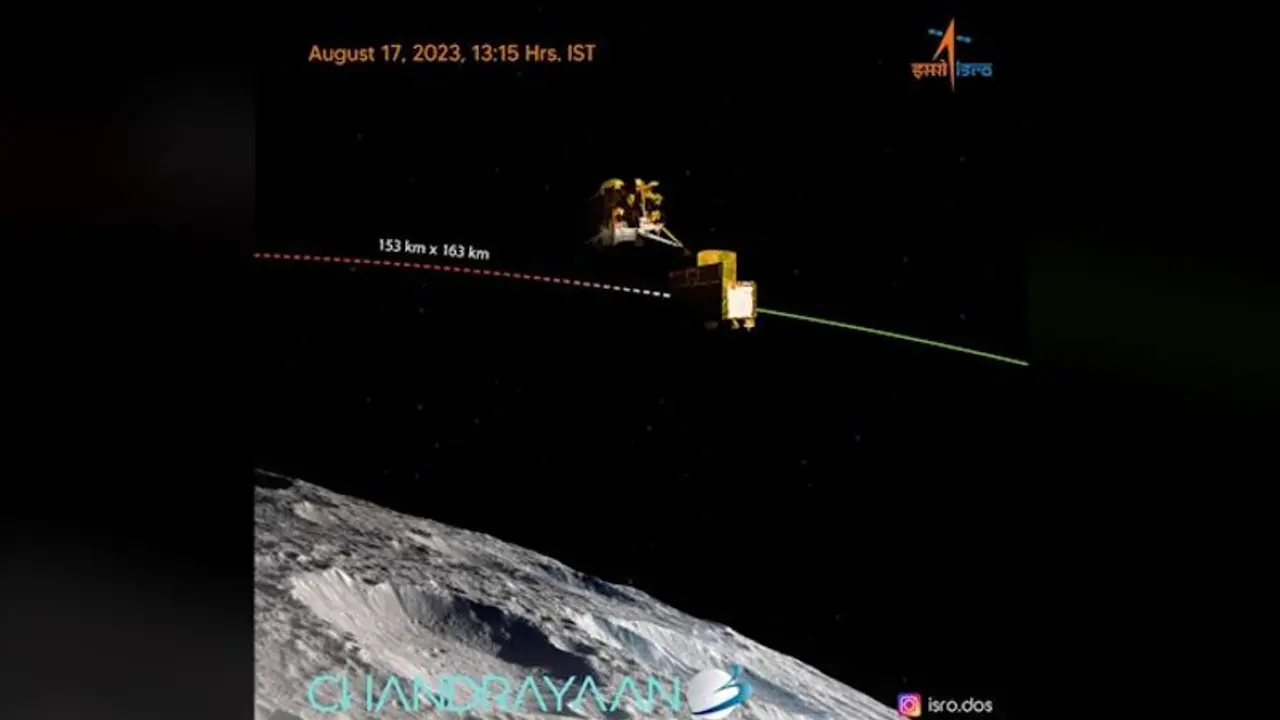ISRO has outlined that the propulsion module's mission extends across several months or potentially even years as it remains in Earth's orbit. During this time, it will perform spectroscopic assessments of Earth's atmosphere and gauge the polarization of light emitted by the planet's clouds.
The Vikram lander of the Chandrayaan-3 spacecraft has effectively detached from its propulsion module today, progressing on its path toward the Moon with the anticipated achievement of a gentle landing on August 23rd. Expressing its departure, the Lander Module (LM) conveyed a lighthearted, "Thanks for the ride, mate!" The successful separation from the Propulsion Module (PM) was confirmed by ISRO, which communicated through its platform X, previously recognized as Twitter.

ISRO shared that the LM is set to gradually descend into a marginally lower orbit after a planned deboosting operation scheduled for tomorrow around 1600 Hrs, IST.
Chandrayaan-3 marks giant leap, lander 'Vikram' successfully separates from propulsion module
What happens to the propulsion module?
The core functioning unit of the spacecraft, known as the propulsion module, has the pivotal role of transporting the lander module into a secure lunar orbit.
ISRO has outlined that the propulsion module's mission extends across several months or potentially even years as it remains in Earth's orbit. During this time, it will perform spectroscopic assessments of Earth's atmosphere and gauge the polarization of light emitted by the planet's clouds.
"Effectively separating from the Propulsion Module (PM), the LM has smoothly detached. A planned deboosting maneuver is in store for the LM to gradually transition into a slightly lower orbit," ISRO communicated via its platform X, formerly identified as Twitter.
Initiated on July 14, Chandrayaan-3 embarked on its space journey via the LVM3 rocket, launched from the Satish Dhawan Space Centre situated in Sriharikota.
BJP MLAs demand discussion on Sheesh Mahal, marshalled out from Delhi assembly amid uproar
The propulsion module facilitated the conveyance of both the Vikram lander and the Pragyaan rover configuration into a lunar orbit spanning 100 kilometers. Subsequently, the lander autonomously disengaged from the propulsion module, and its upcoming objective involves orchestrating a gentle touchdown on the lunar terrain.
The propulsion module serves as the carrier for the SHAPE payload, a crucial apparatus set to scrutinize the characteristics of light emanating from Earth through both spectral and polarimetric analysis.
"Embracing the SHAPE payload, this onboard system is poised to undertake an intricate spectroscopic investigation of Earth's atmospheric composition. Furthermore, it will meticulously gauge the shifts in light polarization originating from Earth's cloud formations, an endeavor aimed at amassing distinctive markers delineating exoplanets with potential habitability," conveyed ISRO via the platform X.
Chandrayaan-3, positioned as a sequent mission following the trajectory of Chandrayaan-2, is poised to make a significant endeavor—an attempted lunar spacecraft landing coupled with the deployment of a rover designed for comprehensive lunar surface exploration. The rover's mission mandate encompasses the comprehensive acquisition of data pertaining to the moon's geological composition and structure, thereby furnishing scientists with valuable insights into the historical progression and transformation of our neighboring celestial companion.
Noida man performs stunt on car roof, owner fined Rs 26,000 | WATCH
In parallel to its primary ambition of achieving lunar landing precision, Chandrayaan-3 is poised to undertake on-site scientific explorations that delve into the intricacies of the lunar environment. This comprehensive scientific endeavor encompasses multifaceted domains such as lunar history, geology, and the latent prospects for resource exploration.
Employing its laser beams, the rover Pragyaan is set to initiate the liquefaction of a portion of the lunar surface, commonly referred to as Regolith. It will also scrutinize the gases that are released during this transformative procedure. This initiative not only promises to amass an abundance of insights concerning the lunar terrain but also casts a spotlight on the plausible prospects of human inhabitation on the moon in the times ahead.
